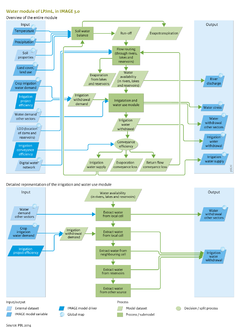Water/Data uncertainties limitations: Difference between revisions
< Water
Jump to navigation
Jump to search
No edit summary |
Oostenrijr (talk | contribs) m (Text replace - "km3" to "km<sup>3</sup>") |
||
| Line 12: | Line 12: | ||
Because uncertainties in precipitation input data propagate through to the calculation of river discharge, multiple climate change scenarios need to be used in assessment of future water availability, as in Gerten et al. ([[Gerten et al., 2013|2013]]). | Because uncertainties in precipitation input data propagate through to the calculation of river discharge, multiple climate change scenarios need to be used in assessment of future water availability, as in Gerten et al. ([[Gerten et al., 2013|2013]]). | ||
LPJmL’s reservoir operation scheme simulates management of 7000 of the world’s largest reservoirs, as well as withdrawal and distribution of irrigation water from those reservoirs. Biemans et al. ([[Biemans et al., 2011|2011]]) calculated that reservoirs contribute annually around 500 | LPJmL’s reservoir operation scheme simulates management of 7000 of the world’s largest reservoirs, as well as withdrawal and distribution of irrigation water from those reservoirs. Biemans et al. ([[Biemans et al., 2011|2011]]) calculated that reservoirs contribute annually around 500 km<sup>3</sup> of irrigation water. As there are no other studies that quantify the contribution of reservoirs to irrigation, the uncertainty in this estimation is difficult to determine. | ||
Globally, groundwater contributes around one third of the water supply used for irrigation. Groundwater availability is not explicitly included in the model and there are no global data on the quantity of usable groundwater storage. Siebert ([[Siebert, 2010|2010]]) provides such an assessment without differentiating between renewable and fossil groundwater. As it is unknown how long various groundwater reservoirs could continue to be exploited, uncertainty about future availability of groundwater resources results in uncertainty in the assessment of future water stress. | Globally, groundwater contributes around one third of the water supply used for irrigation. Groundwater availability is not explicitly included in the model and there are no global data on the quantity of usable groundwater storage. Siebert ([[Siebert, 2010|2010]]) provides such an assessment without differentiating between renewable and fossil groundwater. As it is unknown how long various groundwater reservoirs could continue to be exploited, uncertainty about future availability of groundwater resources results in uncertainty in the assessment of future water stress. | ||
Revision as of 10:42, 1 July 2014
Parts of Water/Data uncertainties limitations
| Component is implemented in: |
|
| Related IMAGE components |
| Projects/Applications |
| Key publications |
| References |
